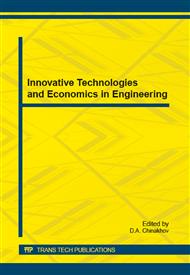[1]
G. V. Samsonov. Nitridy, Naukova dumka, 196, pp.133-158.
Google Scholar
[2]
Donald M. Mattox. Handbook of Physical Vapor Deposition (PVD) Processing, Second Edition, Published by Elsevier Inc., (2010).
DOI: 10.1016/b978-0-8155-2037-5.00016-2
Google Scholar
[3]
P. Motte, M. Proust, J. Torres, Y. Gobil, Y. Morand, J. Palleau, R. Pantel. TiN-CVD process optimization for integration with Cu-CVD, Microelectronic Eng. 50 (2000), pp.369-374.
DOI: 10.1016/s0167-9317(99)00304-4
Google Scholar
[4]
D.S. Rickerby, P.J. Burneet. The wear and corrosion resistance of hard PVD coatings, Surf. Coat. Technol. 33 (1987) 191–211.
DOI: 10.1016/0257-8972(87)90188-5
Google Scholar
[5]
F. Qunlang, Z. Yu. The corrosion resistance and wear resistance of thick TiN coatings deposited by arc ion plating, Surf. Coat. Technol. 145 (2001) 80–87.
DOI: 10.1016/s0257-8972(01)01284-1
Google Scholar
[6]
D. A. Jager, D. Stover, W. Schlump. High pressure plasma spraying in controlled atmosphere up to two bar, ITSC'92, 1992, Orlando, Florida, USA, pp.69-74.
Google Scholar
[7]
Smith, R. W., Lugscheider, E., Jokiel, P., Mueller, U., Merz, J., & Wilbert, M. Synthesis of composite materials by reactive plasma-spray processing. In Thermal Spray Coat.: Res., Design Appl., Proc. Natl. Spray Conf. (1993), pp.439-444.
Google Scholar
[8]
A. Kobayashi. Formation of TiN coatings by gas tunnel type plasma reactive spraying, Surf. Coat. Technol. 132 (2000) 152–157.
DOI: 10.1016/s0257-8972(00)00725-8
Google Scholar
[9]
T. Bacci, L. Bertamini, F. Ferrari, F.P. Galliano, E. Galvanetto. Reactive plasma spraying of titanium in nitrogen containing plasma gas, Mater. Sci. Eng. A A283 (2000) 189–195.
DOI: 10.1016/s0921-5093(00)00704-8
Google Scholar
[10]
W. Feng, D. Yan, J. He, G. Zhang, Appl. Surf. Sci. 243 (2005) 204–213.
Google Scholar
[11]
E. Galvanetto, F.P. Galliano, F. Borgiolia, U. Bardi, A. Lavacchi. XRD and XPS study on reactive plasma sprayed titanium/titanium nitride coatings, Thin Solid Films 384, 2001, 223-229.
DOI: 10.1016/s0040-6090(00)01871-x
Google Scholar
[12]
P. Seyffarth, I.V. Krivtsun. Laser-Arc Processes and their Applications in Welding and Material Treatment. Welding and Allied Processes. Vol. 1, Taylor&Francis, (2002).
DOI: 10.1201/9781482264821
Google Scholar
[13]
S.V. Petrov, I.N. Karp. Plazmennoe gazovozdushnoe napylenie, Kiev, Naukova dumka, 1993, 494 p.
Google Scholar
[14]
Patent of Ukraine UA В23К10/00 Plazmotron dlya napylennya pokryttiv / Borisov Yu.S., Voynarovych S.G., Fomakin O.O., Yuschenko K.A. (Ukraine(UA); No. 2002076032; 19. 07. 2002 р., Published 16. 06. 2003, No. 6.
Google Scholar


